AI-powered image generation can transform your blog by providing quick, cost-effective, and creative visuals that boost engagement and storytelling. With tools like Midjourney, Adobe Firefly, and social platforms offering easy-to-use interfaces, you can generate high-quality images tailored to your content. However, it’s important to contemplate ethical use and copyright issues. Keep exploring how these technologies can upgrade your blog’s visuals and reader appeal for a more impactful online presence.
Key Takeaways
- AI-powered image generation enables creating custom visuals that enhance blog content and increase reader engagement.
- Integration of AI tools like Midjourney or Adobe Firefly allows seamless automatic image insertion into blog posts.
- Personalized and dynamic visuals generated by AI can improve content relevance and audience retention.
- Using AI for images reduces costs and production time compared to traditional graphic creation methods.
- Ethical considerations and clear disclosure are essential when incorporating AI-generated images in blogs.
The Rise of AI Image Generation in Content Creation

The rise of AI image generation has transformed content creation by making visual assets faster, cheaper, and more versatile. With 71% of social media images now AI-generated, you can see how mainstream this trend has become. AI marketing is fueling this shift, enabling marketers to craft compelling visual storytelling that engages audiences more effectively. Over 80% of global marketers incorporate AI into their strategies, using it for blog visuals, social media posts, and branded content. This technology allows you to test multiple variations quickly, optimize engagement, and deliver hyper-personalized visuals tailored to specific audience segments. As AI-generated images become integral to content workflows, brands are investing heavily in creative strategies, fostering innovation while reducing traditional production costs and boosting overall marketing efficiency. AI content clusters further support these efforts by organizing visual content and enhancing overall SEO performance.
Key Technologies Behind AI-Powered Visuals
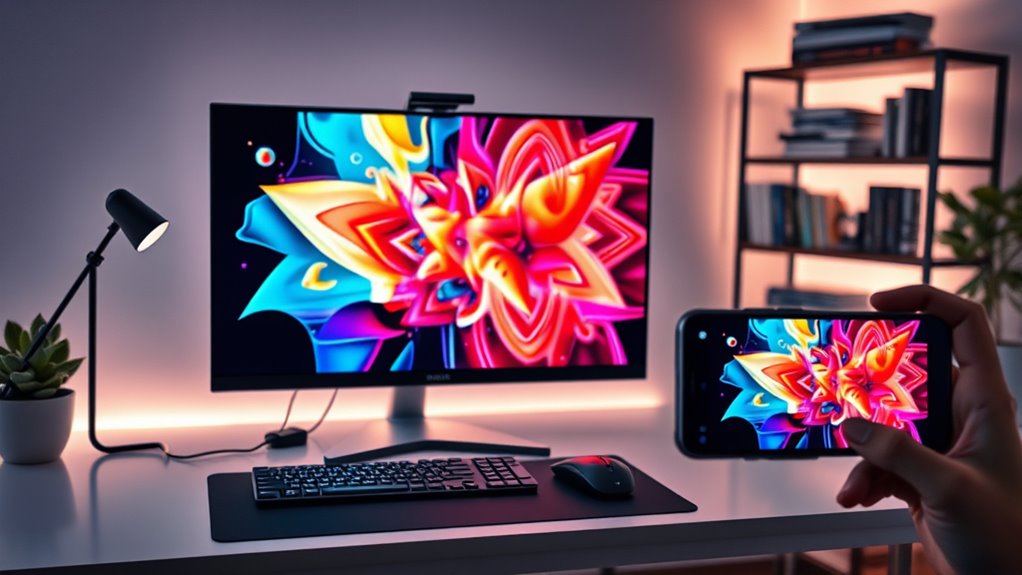
At the core of AI-powered visuals are advanced technologies that enable machines to understand and generate images with remarkable accuracy. Neural architecture plays a vital role, mimicking the human brain’s structure with interconnected layers that process complex visual information. These networks learn from dataset diversity, which includes millions of varied images like animals, landscapes, and abstract art, allowing the AI to recognize patterns and features across different styles. By training on large, diverse datasets, neural networks develop the ability to synthesize new visuals that are both contextually relevant and stylistically varied. Neural networks process visual data to recognize features and generate new images based on learned patterns. This combination of neural architecture and dataset diversity forms the foundation for sophisticated image generation models, empowering bloggers to create unique, high-quality visuals effortlessly. Additionally, ongoing advancements in deep learning techniques continue to enhance the realism and creativity of AI-generated images.
Popular Platforms and Tools for Bloggers
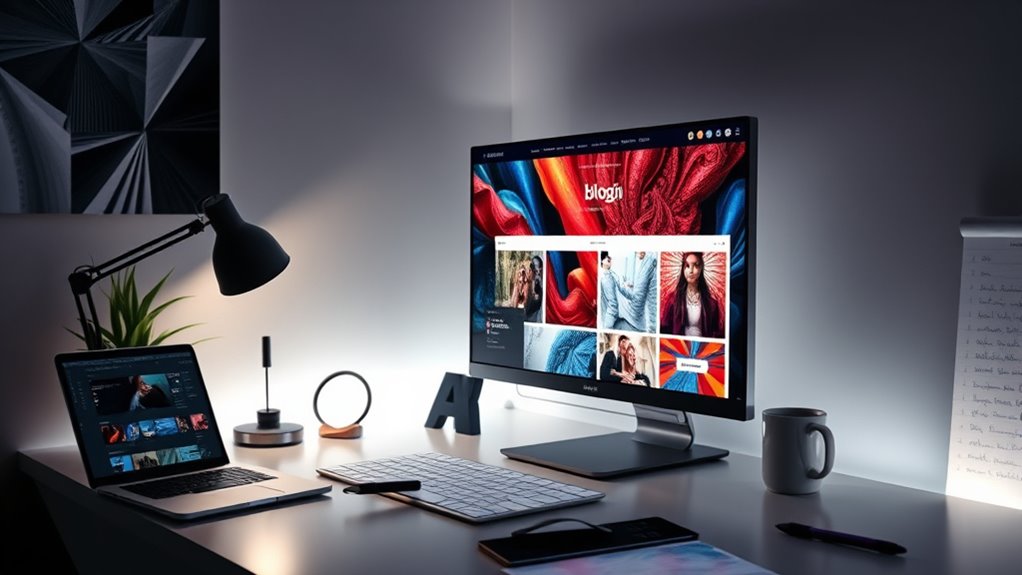
Bloggers now have access to a variety of AI-powered platforms and tools that make visual content creation more accessible and efficient. Midjourney excels in artistic and cinematic images, popular for rich textures and styles inspired by studios like Ghibli. Meta AI’s social integration offers beginner-friendly, free image generation directly within platforms like Instagram and Facebook, though watermarks and AI art ethics considerations may limit commercial use. Adobe Firefly, part of Adobe’s suite, provides professional-grade images with seamless editing, ideal for designers mindful of copyright disputes. ChatGPT’s image capabilities offer versatile and easy-to-use options for content planning. Specialized tools like Re focuses on prompt accuracy, while others like NightCafe and Tensor.Art offer customization and open-source flexibility, helping you navigate the evolving landscape of AI art ethics. Understanding fan culture can also inspire more engaging visual narratives that resonate with communities.
Integrating AI Images Into Your Blog Workflow

To smoothly incorporate AI-generated images into your blog, start by obtaining API access keys from providers like OpenAI or Hugging Face, which authenticate your requests. Use workflow automation platforms such as AI-FLOW or Zapier to create pipelines that trigger image generation based on your content. Configure nodes or bricks to define prompts, styles, resolution, and other parameters for precise output. Integrate tools like WordPress plugins or APIs for seamless image assignment, such as setting featured images automatically. Optimize prompts with clear, detailed instructions to generate relevant images consistently. Advanced text-to-image models like GPT Image can produce highly realistic visuals that enhance your blog posts. To ensure your images align with your content themes, consider incorporating relevant keywords into your prompts for more targeted results. Automate post-processing tasks like resizing, cropping, or watermarking within your workflow. By streamlining these steps, you’ll ensure high-quality, on-demand images that enhance your blog’s visual appeal and efficiency.
Enhancing Engagement Through AI-Generated Content
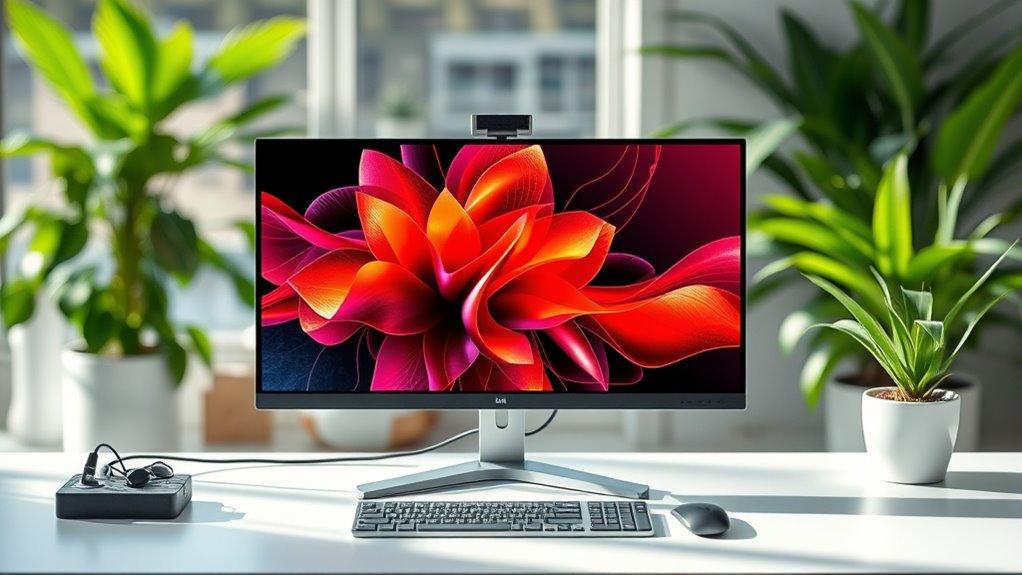
Have you noticed how AI-generated images can considerably boost your blog’s engagement? These visuals increase reader interaction by 25%, especially when combined with personalized content. AI-driven personalization also raises comment rates by 20%, making your audience feel more connected. Interactive elements like dynamic visuals invite real-time engagement, while visual storytelling reinforces SEO and retention. Younger audiences, such as Gen Z and Millennials, prefer vibrant, interactive content, which AI can deliver effortlessly. Additionally, understanding your audience’s relationship dynamics helps tailor visuals that resonate more deeply. However, maintaining content originality remains essential; guarantee your AI tools produce unique, authentic visuals that reflect your voice. While AI enhances engagement, it’s imperative to address AI ethics, ensuring transparency and responsible use to build trust. By thoughtfully leveraging AI-generated content, you’ll create more engaging, authentic experiences for your readers.
Ethical and Copyright Considerations in AI Imagery
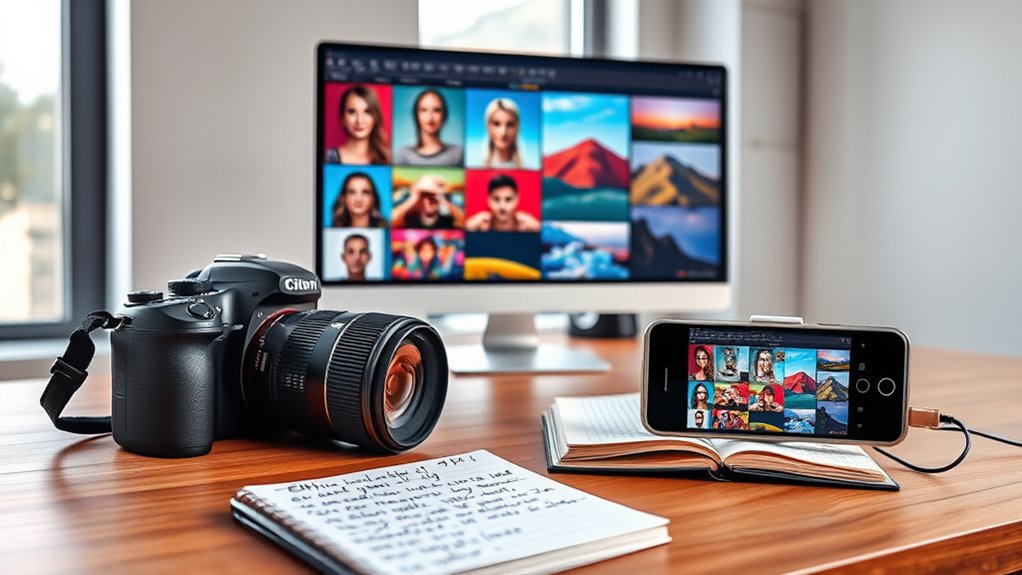
When using AI-generated images, you need to consider who owns the copyright, since current laws require human authorship for protection. Responsible use involves ensuring your images don’t infringe on existing works or misappropriate artists’ rights. Addressing these ethical and legal issues helps maintain trust and avoids potential legal risks. Furthermore, AI-generated art cannot be copyrighted, and understanding the limits of legal attribution is crucial to avoid unintentional infringement. Additionally, the AI security landscape continues to evolve, emphasizing the need for ongoing awareness of potential vulnerabilities and biases in AI outputs.
Copyright Ownership Challenges
The question of who owns AI-generated images remains a complex challenge in today’s legal landscape. Currently, AI-created works aren’t eligible for copyright because they lack human authorship, as courts reaffirm. This means your images often fall into the public domain, with no clear ownership for you, the creator, or the developer. Legal restrictions also prevent AI-generated works from being granted copyright protection, compounding ownership uncertainties. Imagine this:
| User | AI Model | Copyright Status |
|---|---|---|
| Provides prompt | Processes input | No copyright, public domain |
| Curates output | Generates image | Ownership uncertain |
| Uses image commercially | Legal compliance? | Risk of infringement |
Ownership ambiguities impact intellectual property rights and legal compliance. Without clear protections, disputes and liability issues increase, emphasizing the need for clarity in this evolving field.
Responsible AI Usage
Responsible use of AI-generated images requires careful attention to ethical and legal considerations. You need to be aware of AI bias, which can cause stereotypes and unfair portrayals, especially of marginalized groups. Ensuring fair representation involves scrutinizing training data and monitoring outputs for bias. Data privacy is equally vital; using personal photos or social media content without consent risks violating privacy rights and legal boundaries. Transparency about how AI models are trained and how data is collected helps build trust and reduces misinformation. You should also disclose when images are AI-generated to avoid deception. AI bias can perpetuate harmful stereotypes, making ongoing oversight essential. By prioritizing ethical practices, respecting privacy, and actively addressing bias, you maintain responsible AI usage that benefits your audience and upholds legal standards. Additionally, understanding the training data sources used for AI models can help identify potential biases and improve the fairness of generated images.
Future Trends and Innovations in AI Image Tech
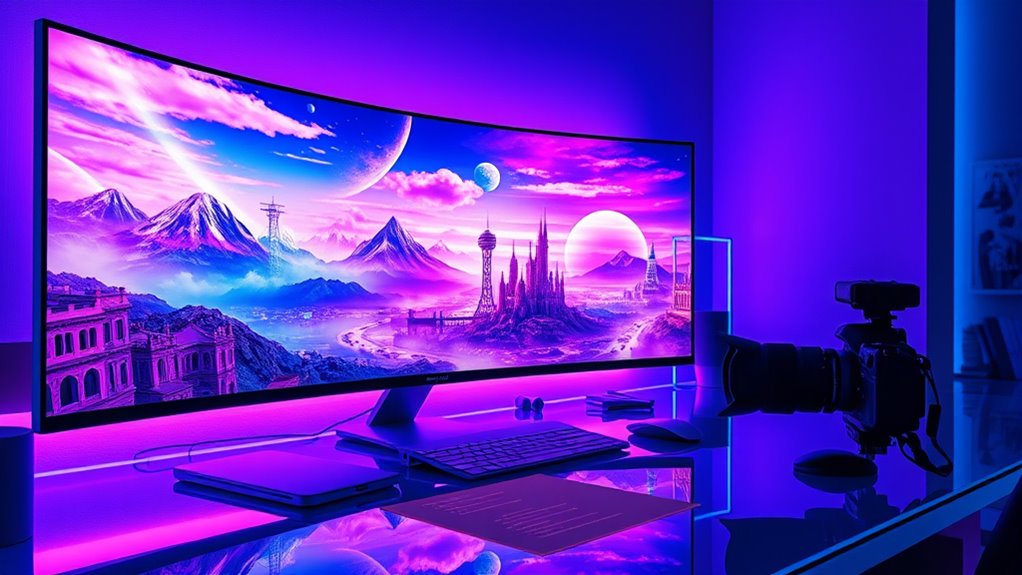
Future innovations in AI image technology will make real-time image synthesis more seamless, allowing you to generate visuals instantly within your workflows. Enhanced customization options will give you greater control over style, detail, and context, making images more tailored to your needs. Additionally, AI-driven creative collaboration tools will enable you to co-create with AI, expanding your creative possibilities beyond traditional limits. By integrating asset division strategies, these tools can also assist in visualizing complex scenarios for legal or financial planning.
Real-Time Image Synthesis
Advances in real-time AI image synthesis algorithms are transforming how digital content is created and experienced. Techniques like GANs and diffusion models now produce highly photorealistic images with stylistic flexibility, optimized for temporal consistency in videos and interactive environments. As quantum computing progresses, it could accelerate processing speeds, making real-time synthesis even more seamless. Emotional analysis integrated into AI models enables the creation of images that resonate more deeply with users, enhancing engagement. Deep learning techniques improve the quality and efficiency of image generation by enabling models to learn complex visual features from large datasets. Efficiency improvements, such as model compression and parallel processing, allow these innovations to run smoothly on consumer hardware, including mobile devices. This evolution supports dynamic applications like virtual reality, live streaming, and interactive gaming—where user engagement and real-time, immersive visuals are essential for a richer digital experience.
Enhanced Customization Options
Enhanced customization options in AI image generation are set to revolutionize how you craft visuals for blogs. You’ll soon enjoy finer control over style personalization, allowing you to apply nuanced artistic styles from specific artists or movements with precision. Personalized style profiles enable consistent aesthetic matching by inputting your favorite samples. Future advancements will let AI adapt styles dynamically based on content or themes within your images. Additionally, attribute control will give you extensive sliders for lighting, shadow, color, and mood effects, tailoring images to your needs. You can even define scene complexity or atmospheres like weather or time of day. These innovations ensure your visuals are uniquely aligned with your blog’s style, making your content more engaging and visually cohesive. Subtopic 2: Ghibli Style reflects the trend of capturing warmth and nostalgia, and future AI developments will further enhance the ability to generate images with emotional storytelling and fantasy atmospheres.
AI-Driven Creative Collaboration
As AI image generation tools become more sophisticated in offering customization, they also open new horizons for creative collaboration. Neural artistry and aesthetic fusion enable you to blend diverse styles, from hyperrealism to retro aesthetics, easily. Advanced multimodal inputs allow you to combine text prompts with reference images, refining outputs through real-time feedback. Interactive interfaces facilitate joint decision-making on style, composition, and details, fostering a dynamic creative process. AI-assisted brainstorming tools suggest variations aligned with your goals, accelerating innovation. Cross-disciplinary inputs—merging art, photography, and design—lead to richer, more unique creations. AI-generated images are increasingly being integrated into professional workflows, enhancing productivity and inspiring new artistic directions. This collaborative approach empowers you to push artistic boundaries, explore avant-garde storytelling, and develop hybrid styles that resonate with your vision, all while maintaining transparency and ethical standards.
Best Practices for Using AI-Generated Images Responsibly

Using AI-generated images responsibly requires clear planning and adherence to ethical standards. First, define specific use cases—like blog illustrations or marketing assets—that add real value, avoiding misuse. Second, establish ethical standards to prevent misleading content, such as misrepresenting real people or events, and respect privacy and copyright dilemmas. Third, inform your team about AI capabilities and limitations to set realistic expectations and ensure transparency. Follow these steps: 1. Develop guidelines to prevent misrepresentation and copyright violations. 2. Use precise prompts to generate relevant, high-quality images. 3. Clearly disclose AI image creation and attribute tools as needed. Understanding AI image generation and its applications ensures responsible and effective use.
Frequently Asked Questions
How Can I Improve the Quality of Ai-Generated Images for My Blog?
To improve the quality of AI-generated images, focus on style refinement and resolution enhancement. Make your prompts more specific, describing lighting, environment, and details clearly. Experiment with style tags to match the desired aesthetic, and select models that excel in resolution. Use post-processing tools to adjust color, contrast, and sharpness, ensuring your images look professional. This combination boosts clarity, style, and overall visual appeal for your blog.
Are There Costs Associated With Using AI Image Generation Platforms?
Think of AI image platforms as digital marketplaces where every click and creation costs a toll. You’ll encounter subscription fees that release higher usage limits and remove restrictions, much like upgrading a toll pass. Some platforms offer free tiers, but they come with limits that can feel like narrow roads. To access premium features or commercial rights, expect to pay more—your wallet’s the tollbooth deciding how far you can go.
Can AI Images Be Customized to Match My Blog’S Branding?
You can customize AI images to match your blog’s branding, ensuring brand consistency and color matching. By using AI tools that embed your brand assets, color palettes, and style guidelines, you control the visual elements, maintaining a cohesive look. Additionally, custom AI models remember your brand specifics, enabling consistent, on-brand visuals across posts. This approach helps reinforce your brand identity while streamlining your content creation process.
What Are the Best Ways to Credit Ai-Generated Visuals Ethically?
Imagine you’re crafting a masterpiece in the age of AI, like a modern Da Vinci. To credit AI-generated visuals ethically, you should clearly label them as AI-created and specify the tool or platform used. Practice ethical sourcing by disclosing AI involvement upfront, ensuring transparency. Proper AI attribution respects copyright, helps avoid misinformation, and maintains trust with your audience. It’s about honest recognition and responsible sharing in the digital age.
How Do I Ensure Ai-Created Images Are Copyright-Compliant?
To guarantee AI-created images are copyright-compliant, you need to take into account copyright considerations and licensing requirements. You should include meaningful human input, like editing or customizing images, to establish authorship. Verify the licensing of AI tools and training data, using licensed or public domain sources whenever possible. Keep records of your creative process, and stay updated on legal rulings, so your use aligns with current regulations and avoids infringement risks.
Conclusion
As you weave AI-generated images into your blog, imagine your content blooming like a vibrant garden, each visual a colorful bloom that captivates your readers. Embrace these tools responsibly, like a skilled gardener tending to delicate blooms, and watch your audience grow enchanted by your creative landscape. With AI imagery, your blog transforms into a tapestry of innovation and inspiration—where every picture tells a story and sparks limitless imagination.









